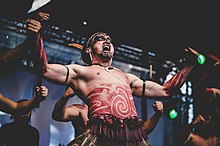
Back Schlochtruaf BAR Боен вик Bulgarian Schlachtruf German Grito de guerra Spanish رجزخوانی Persian Sotahuuto (sodankäynti) Finnish Liste de cris de guerre French קריאת קרב HE Lista di grida di guerra Italian 鬨 Japanese


A battle cry or war cry is a yell or chant taken up in battle, usually by members of the same combatant group. Battle cries are not necessarily articulate (e.g. "Eulaliaaaa!", "Alala"..), although they often aim to invoke patriotic or religious sentiment. Their purpose is a combination of arousing aggression and esprit de corps on one's own side and causing intimidation on the hostile side. Battle cries are a universal form of display behaviour (i.e., threat display) aiming at competitive advantage, ideally by overstating one's own aggressive potential to a point where the enemy prefers to avoid confrontation altogether and opts to flee. In order to overstate one's potential for aggression, battle cries need to be as loud as possible, and have historically often been amplified by acoustic devices such as horns, drums, conches, carnyxes, bagpipes, bugles, etc. (see also martial music).
Battle cries are closely related to other behavioral patterns of human aggression, such as war dances and taunting, performed during the "warming up" phase preceding the escalation of physical violence. From the Middle Ages, many cries appeared on speech scrolls in standards or coat of arms as slogans (see slogan (heraldry)) and were adopted as mottoes, an example being the motto "Dieu et mon droit" ("God and my right") of the English kings. It is said that this was Edward III's rallying cry during the Battle of Crécy. The word "slogan" originally derives from sluagh-gairm or sluagh-ghairm (sluagh = "people", "army", and gairm = "call", "proclamation"), the Scottish Gaelic word for "gathering-cry" and in times of war for "battle-cry". The Gaelic word was borrowed into English as slughorn, sluggorne, "slogum", and slogan.